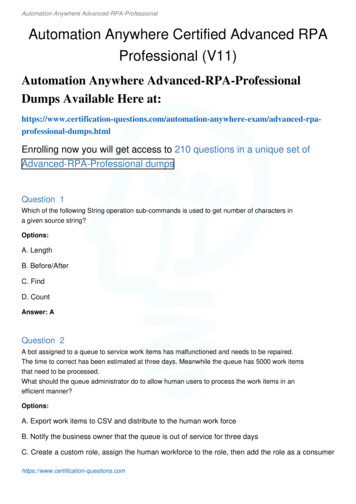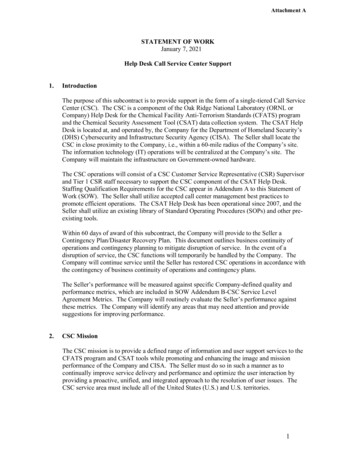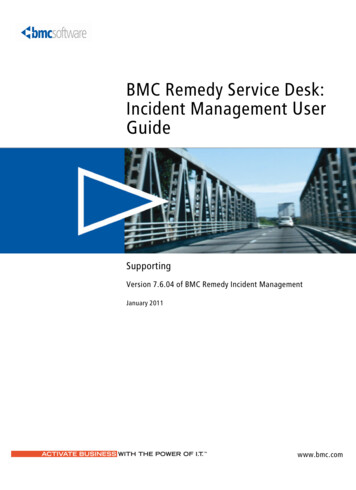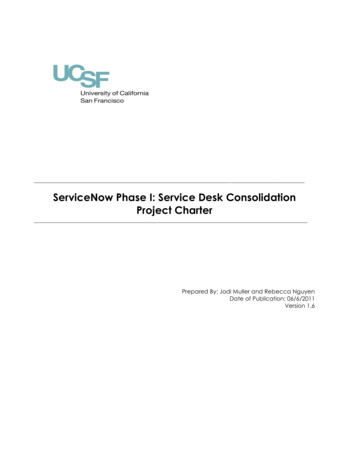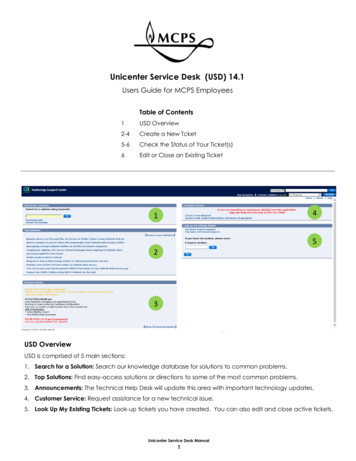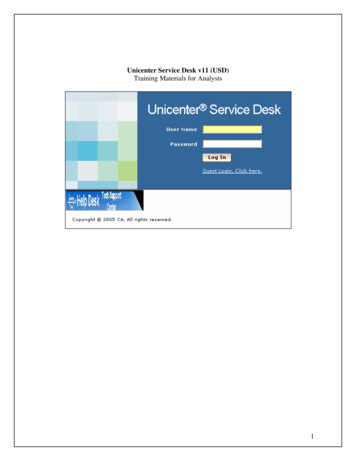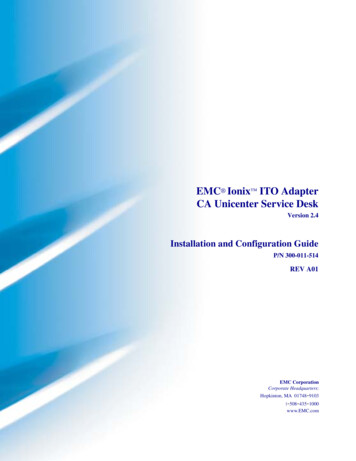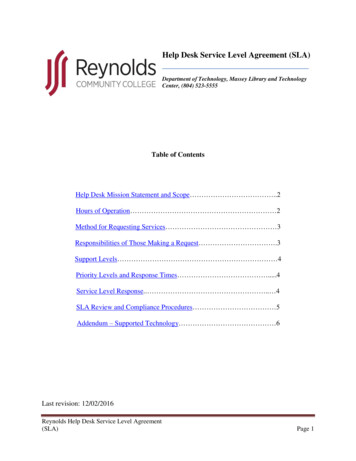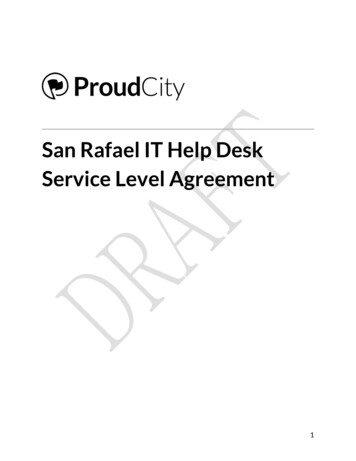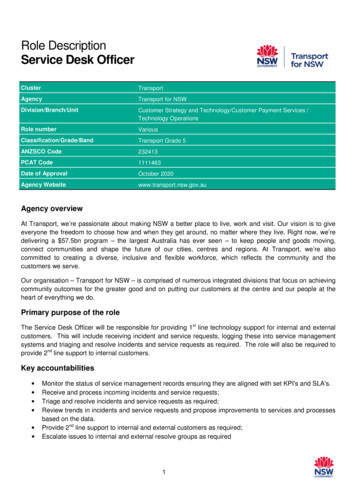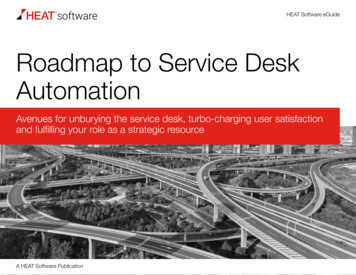
Transcription
HEAT Software eGuideRoadmap to Service DeskAutomationAvenues for unburying the service desk, turbo-charging user satisfactionand fulfilling your role as a strategic resourceA HEAT Software Publication
Roadmap to Service Desk AutomationContentsYour Guide . 2Service Automation & Workflow. 3Self Service & Service Catalog. 7Telephony Integration. 11Conclusion: Next Steps. 15A HEAT Software Publication
Roadmap to Service Desk AutomationYour guide to eliminating the roadblocksHigher user expectations. Greater demand. More responsibility. Butno increase in staff or money. Despite the role your service desk playsin supporting your company, it’s highly unlikely your CEO is going tocongratulate you with more budget because you’re doing a fantastic job.More likely, staff and budget remain static while your service desk dealsheroically with piles of tickets.And let’s face it, technology isn’t always a help: In fact, technologynow enables your service desk managers to do a lot of the operationsdepartment’s jobs too: like patch management or installing software atcustomer request. And if you’re not geared up to deal with that increasedload, you’ll find things slipping farther behind.Hence this roadmap and some good news: Your current staffing,budget and infrastructure can easily deliver far more, and this guide willwalk you through three proven avenues for making it happen. We’ll alsodescribe real-world success stories, all underpinned by HEAT Software’sexperience in working with thousands of service managers over the last20 years — and according to best-practice strategies that we’ve seenproven time and again.So let’s get moving! You’ll see how to cutyour backlog of incidents, increase firstcall resolution and use automated selfservice to deliver more with the resourcesyou have now.A HEAT Software Publication2
Service Automation& WorkflowA HEAT Software Publication3
Service Automation and WorkflowYour OpportunityPowering new efficiency across all avenuesThe bottom line: Making life better and more satisfying for everyone— service desk agents and users — is the ultimate measure of yoursuccess. And automation is key to gaining the control you need overworkflows to do so. Here’s why:Automation eliminates redundant activities. For example, an emailwith multiple recipients can be unclear about who is meant to do what.Using workflow engines to control that information flow makes assigningtasks automatic.It reduces time spent on routine tasks. Want to lower service deskagents’ job satisfaction? Give them the same job to do over and overagain. Agents like being heroes, solving interesting problems, notautomatons. So put anything repetitive in an automated workflow.You enjoy more repeatable and consistent decision-making. Highanalyst turnover is a reality. So why make new agents reinvent thewheel? Let automation and workflow handle common issues, so agentscan focus on answering more pressing employee questions.Unnecessary downtime is eliminated. For example, automation canlower downtime in change and release processes. Changes can berouted through advisory boards enabling early identification of conflicts— avoiding interruptions and raising customer satisfaction.See how University of Oxford graduated to thebenefits of automated self-service with HEAT“Our partnership with HEAT Software will play an important role inkeeping thousands of IT users operational and our IT teams happy.”John IrelandDirector of Customer Services,University of OxfordA HEAT Software PublicationREAD THE CASE STUDY4
Service Automation & WorkflowFirst Steps & MilestonesMapping the route“Automation applied to an efficient operation will magnify the efficiency. Automationapplied to an inefficient operation will magnify the inefficiency.”— Bill GatesSee where you are. Know where you’re going. There’s no pointautomating an inefficient process. So look hard at what’s burying yourservice desk. Is it incident volume? Time to resolution? Find out. Thenset clear goals based on causes — not their effects.Pencil, paper and whiteboard. Before jumping into technology,meet with the constituents to note the details of specific problems.Then manually whiteboard the broader information flow and figure outwhat the actual processes involved are. Pick one or two high impactprocesses to automate first.Design process workflow. Now we can design a process workflow— letting the tools take over in guiding the activities we’ve definedmanually.Determine required integrations. This is key. For example, remediationmay be needed for Flash users who need a patch to get up to the latestversion. With the right integrations in place, that can happen from withinthe service desk with no extra steps.Execute the process automation. Set up your process workflow inyour workflow engine and then publish the automated workflow to theservice desk.Measure! Once automation is a go, you need to measure the outcomeon an on-going basis. You’ll see how close you are to your goals, andbe able to refine and improve over time. First workflow working well?Repeat for the other high impact processes on your hit list.A HEAT Software Publication5
Service Automation and WorkflowArriving At The BenefitsWhat to expect. Plus, a real-world journey.So you’ve given it your all. What’s service automation giving in return?We know it’s going to increase your efficiency by reducing downtimeand eliminating redundant activities. But there’s more:Maintenance costs fall. Automating event tracking gives you awindow into equipment availability. You’ll know when machines needmaintenance or replacement and can act proactively — extendingequipment life and preventing customer frustration.You gain end-to-end visibility. Complete visibility into service levelperformance is invaluable when addressing budget needs to seniormanagement. And you’ll have all the data you need to provide a clearpicture of your benefits to the company.Improved service quality. Employee satisfaction is the core reason forevery IT department’s existence. That’s why keeping users happy andefficient is what service automation is all about, and why it’s essential tohelping your group in its role as a strategic asset.Change Approvals: A Real-World JourneyFor one HEAT customer, change approvals were a roadblock to progress. A change advisoryboard working with manual-driven email processes took ages to reach consensus — untilHEAT automated the workflow.Before Automation Approvals get lost in email No way to support approval criteria Serial approval processWith Automation Emails can still be used, now with reminders to those that don’t act Better approval controls. For example any deny can stop the change, or 51% approverscan approve, etc. Parallel approval process shortens approval timelineA HEAT Software Publication6
Self Service &Service CatalogA HEAT Software Publication7
Self Service & Service CatalogYour OpportunityAutomating consumerization of the service desk48% of users first try to help themselves.— GartnerNo surprise: Most people prefer to solve problems themselves — justas they prefer an ATM to waiting in line for a cashier. So here’s whyautomated service catalogs are key to unburying your service desk:Self-service catalogs are users’ first choice. Give employees whatthey’re looking for and they’ll unbury your service desk for you — and asGartner points out, most people are looking to help themselves.It’s quicker and easier than tickets. Rather than look at self-serviceas ticket intake, look at it as a faster, easier way for employees orcustomers to consume your services.Disruption to productivity is minimized. Self-service and servicecatalogs get users up, running, and working productively far faster thanif they have to go through the service desk.Increases the value of your services without adding headcount.Service catalogs can widen your range of services to includesophisticated business requests such as employee onboarding — inaddition to helping with traditional IT issues.See how HEAT makes service management abreeze for the County of Maui“The more we work with HEAT, the better our IT processes become andthat allows us to improve the delivery of IT services to our customers.”Carmela HoService Desk Supervisor,County of MauiA HEAT Software PublicationREAD THE CASE STUDY8
Self Service & Service CatalogFirst Steps & MilestonesMapping the routeImportant: Recognize that an automated service catalog is a work inprogress. You probably won’t succeed if you try to get it all done in onego — so stage it out, bearing in mind these important steps:Start with your top five incident items. Identify the issues that mostcommonly arrive and that have known solutions — and put them up firstin your service catalog.Canvas your users. Ask employees what they’d like to see and createyour builds based on their replies. In other words, treat them likecustomers for whom you’re creating products.Design services users can access themselves. This may seem selfevident. But your biggest initial bang-for-buck will come from capabilitiesthat customers can self-remediate.Leverage Knowledge Management. Well over half of users whoresolve their own issues do so with a knowledge base — so incorporateit, build on it, create knowledge articles and curate!Step Five: Advertise! Go ahead: be a Madman! Users won’t knowabout your new catalog unless you tell them. And keep thinking of waysto remind them using social media and calendars, email, etc.A HEAT Software Publication9
Self Service & Service CatalogArriving at the BenefitsWhat to expect. Plus, a real-world journey.On top of everything else, service catalogs also list the benefits youbring your business, reminding senior management (think CIO) of theadded value you provide. But their core benefits include:Shifting to proactive from reactive. Investing the time to create aservice catalog puts answers in front of users before they even think ofcalling the service desk.Measurability of SLAs. Listing your benefits and tracking them tocatalog usage enables tighter management of SLAs and tracking ofexternal vendors, too.Users are more productive. Self-service and service catalogs canenable users to get back to work much more quickly than if they try tosolve issues through the service desk.Your service desk is more efficient. You as a service desk will haveless busy work. This gives you more time to spend on complicatedissues — solving them faster and boosting user productivity.Higher service quality and customer satisfaction. User self-servicelowers strain on your service desk — translating into happier customers.Employee Onboarding: A Real-World JourneyOnboarding employees was slow and frustrating for a customer who had to manuallycoordinate several different teams — until the service manager established a workflow thatautomatically integrated the efforts of all the players.Before Automated Self Service Many separate teams needed to coordinate Employees began before everything was ready There was no measure for successWith Automated Self Service All necessary details captured up front Costs and chargebacks automatically collected for financial analysis Provision cycles taken care of automaticallyA HEAT Software Publication10
Telephony IntegrationA HEAT Software Publication11
Telephony IntegrationYour OpportunityExtend automation and self-service to the call centerEvery service desk has a voice. And integrating your phone system withyour service desk will make yours sound sweeter and help unbury yourservice desk. Here’s how:Phone integration and call deflection can do everything an agentcan. For example, a user calling to reset a password can be identifiedand authenticated via an API and talked through the reset — with alertssent to that individual and their supervisor for security purposes.Important information can be delivered automatically. Telephonyintegration enables the nature of a call to be identified and relevantinformation sent to users and agents from your knowledge base.Enables proactive problem management. For example, if a routergoes down, telephony integration can be used to answer the flood ofcallers, explain the problem, generate an incident and notify users whenthe issue is resolved.Supports higher activity while lowering costs and raising servicelevels. Phone integration and call deflection lower the cost of servicerequests even as calls rise in number — allowing service desk managersto focus on resolving more complex issues.See why Total Wine is toasting HEAT-enabled ITILprocesses.“Our users love the new HEAT system. Managers love having theinformation they need in easy-to-use dashboards and reports.”Candice PeacockIT Service Desk Manager,Total WineA HEAT Software PublicationREAD THE CASE STUDY12
Telephony IntegrationFirst Steps & MilestonesMapping the routeAs with a service catalog, HEAT recommends that you regard phoneintegration as a work in progress — it just isn’t set and forget. So again,stage it out — based on these critical first steps:Analyze your current situation. Look at your metrics and survey youragents to get data about customer calls, frequency of issues, etc. It willbe vital to optimizing your IVR system’s configuration.Design your solution from the caller’s perspective. Rank callers’top issues, cluster similar ones together and represent them in the firstmenus of your phone system to ensure the shortest path to resolution.Keep navigation simple. Don’t overwhelm users. Limit the number ofdecision levels and menu options, use clear and concise language forprompts and enable users to easily get back to the main menu.Start your engines. Execute with the automation engine driving thevoice-driven workflow.Keep measuring and optimizing! Once you’re rolling, keep an eye onyour metrics, identify issues, find their causes and address them. Users’needs change — and it’s vital to keep up with them.A HEAT Software Publication13
Telephony IntegrationArriving at the BenefitsWhat to expect. Plus, a real-world journey.“We wanted to ensure a positive self-service capability and enhance the clients’experience. HEAT improves our end-to-end service management, making us moreeffective in service delivery.”— Mark McCormackTechnology Support Manager,Queensland University of TechnologyProperly configured, phone integration can handle everything an agentcan — from password resets to service outages. So when incidentsare solved without agents answering the calls, huge benefits accrueincluding:Big cost savings. Automating routine issues such as password resetsand software updates reduces cost per agent pricing when the numberof assigned team members is adjusted accordingly.Improving Service for 45,000 Students:A Real-World JourneyEnrolling 45,000 students a year, Queensland University of Technology’s service desk staffwere stretched — until the service manager enabled users to log and close incidents over the““phone using voice prompts and integrated workflow.and availability to QUT’s support departments.HEAT Service Management has provided far greater productivityWith its ease of deployment, automation, and customization,– Simon Wilkinson, associate director of student systems at QUTseveral people to the workNow they are focusing on these tasks 15 minutes a day, rather than dedicatingHigher customer satisfaction and measurability to SLAs. Usersdon’t wait for a response and self-solve issues quickly — helping servicedesks meet SLA answer times and issue resolution speeds.More productive and satisfied users. Phone integration and calldeflection can enable users to get back to work faster than if theyattempt to resolve issues through the service desk.fulfilled in minutes instead of requiring additional full-time staff.With HEAT, Student Business Services’ productivity has skyrocketed, with requests beingBefore Automated Self Service Burdensome administrative processes Low user self-service Less-than-optimal service desk response Low request accuracy, slow turnaround times 2015 HEAT Software USA Inc. All Rights Reserved.installations, and we know what works and what doesn’t.on configuration knowledge. We have seen many, manyyears of implementation expertise, and practical handsof consultants with a wide range of industry experience,Fusion5 delivers on these principles. We have a teamtheir investments into the future Present opportunities to enable our customers to leveragecommunication and closure Deliver value through speed, effectiveness,new ideas Work with our customers to offer a fresh perspective and Ensure the customer implements the foundations correctlyOur guiding principles include:HEAT, JD Edwards, Oracle, Pivotal and PayGlobal.to implement leading software package solutions such asorganizations that have recently implemented, or are aboutFusion5 aims to provide higher levels of service and value toABOUT FUSION51manual tasksand staff needed forReduction of timefrustrating paper formsElimination ofAustralian Government’s research evaluation exercise (ERA) in 2010end-to-end service management by making us more effective in service delivery.”the clients’ experience,” adds McCormack. “HEAT Software HEAT improves ourrequirements. “We wanted to ensure a positive self-service capability and enhancedeliveryThis commitment to technology adds some complexities to the university’s supportaccess rightsprocesses like grantingpreviously manualAutomation ofend-to-end service(governance and quality) at QUT.More effectivewe can,” says Carmel Brown, manager of service design and business processesstudent services, we want to leverage technology to help streamline processes wheresolutions. While other universities do a bit of online and manual administration forto enroll, assign study plans, define study life cycles, and more through onlinestreamline what were once manual processes for administration. “We allow studentsalso to run the university. QUT uses a number of applications and online services toAt QUT, a focus on technology is important not only in courses and research, butuser-centric online workflowsmanage infrastructure, control costs, and improve service quality.Student Business Services adopted HEAT forto service management, QUT can blend best practices with configurable tools toto handle all IT requests from students and staff. With HEAT’s modern approachand staff experience. QUT deployed HEAT Software HEAT Service Managementacross the University:upgraded its service management tool to provide a responsive and efficientBetterstudentproductivity and service levels attained via the implementation of HEAT have streamlined servicesWith an emphasis on delivering high-quality student services, the university hasfull-time workloads to 15-minute projects Automating assistance processes has significantly reduced Managing incidents is more automated and easierfirst month Self-service resolutions increased 300 percent within theBENEFITSHEAT Service ManagementSOLUTIONWebsite: www.qut.edu.auIndustry: Higher Educationlocation: Brisbane, AustraliaName: Queensland University of TechnologyCOMPANYWith Automated Self ServiceRESPONSIVE AND EFFICIENT SERVICESsays Mark McCormack, manager for technology support at QUT.and fees to rise. “If this occurs, it will drive greater expectations for our services,”Proposed changes to higher education in Australia could cause university tuitionA Rise in Expectationsprofessors for teaching and research.for research, teaching, and learning and is actively recruiting research-capacitythe world, QUT is investing a half billion dollars to build and renew infrastructurearound Brisbane. To continue to attract students from across Australia and aroundor above1. QUT enrolls more than 45,000 student
See how HEAT makes service management a breeze for the County of Maui “The more we work with HEAT, the better our IT processes become and that allows us to improve the delivery of IT services to our customers.” Carmela Ho Service Desk Supervisor, County of Maui 48% of users
